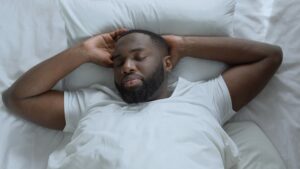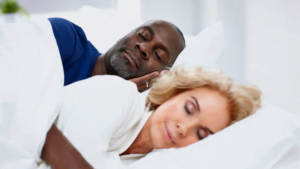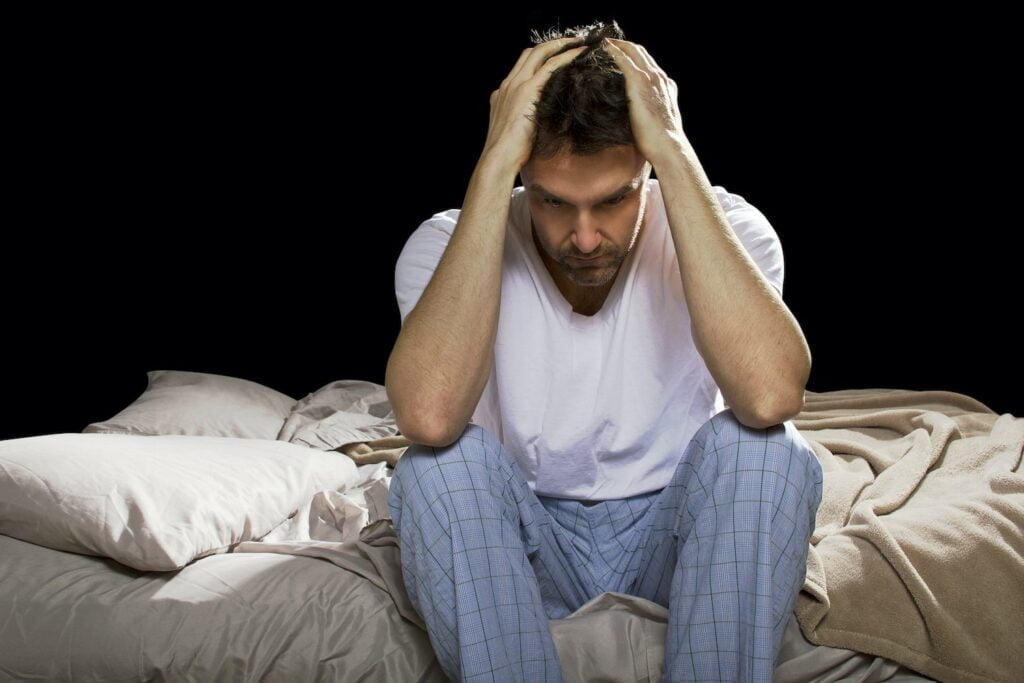Testosterone therapy is a common medical intervention prescribed to address low testosterone levels in men, a condition known as hypogonadism. While this treatment can offer various benefits such as increased energy, improved mood, and enhanced libido, some individuals may experience side effects, including night sweats. In this blog post, we will delve into the relationship between night sweats and testosterone therapy, exploring the potential causes and providing insights into managing this phenomenon.
Contents
Are Night Sweats in Men Linked To Low Testosterone?

Night sweats in men can be linked to various factors, and while low testosterone levels are one possible cause, they are not the only explanation. Night sweats, characterized by excessive sweating during sleep, can result from a range of underlying conditions and lifestyle factors. It’s important to consider various factors when evaluating the potential connection between night sweats and low testosterone levels in men.
Possible Causes of Night Sweats in Men:
- Hormonal Fluctuations: Low testosterone levels can contribute to hormonal imbalances, which may affect the body’s ability to regulate temperature, potentially leading to night sweats.
- Infections: Infections, such as tuberculosis or HIV, can cause night sweats. These conditions trigger the immune system and may lead to increased sweating during sleep.
- Medications: Some medications, including certain antidepressants and medications for diabetes, can have night sweats as a side effect.
- Sleep Apnea: Sleep apnea, a condition characterized by interrupted breathing during sleep, can result in night sweats as the body works harder to restore normal breathing.
- Anxiety and Stress: Mental health factors, such as anxiety and stress, can contribute to night sweats. Hormonal changes associated with stress may play a role.
- Idiopathic Hyperhidrosis: This is a condition characterized by excessive sweating without an apparent cause. It can affect various parts of the body, including during sleep.
- Environmental Factors: Sleeping in a hot or humid environment can lead to night sweats. Using heavy bedding or wearing excessive clothing can contribute to overheating during sleep.
What is Testosterone Therapy?
Testosterone therapy, also known as androgen replacement therapy, is a medical intervention designed to address low levels of testosterone in the body. Testosterone is a crucial hormone that plays a key role in the development and maintenance of male reproductive tissues, muscle mass, bone density, and other bodily functions. In some cases, individuals may experience low testosterone levels, a condition known as hypogonadism, which can lead to a range of symptoms.
Common Symptoms of Low Testosterone:
- Fatigue and reduced energy levels
- Decreased libido (sex drive)
- Erectile dysfunction
- Mood swings and irritability
- Reduced muscle mass and strength
- Increased body fat
- Loss of bone density
Goals of Testosterone Therapy for Night Sweats
Testosterone therapy is primarily prescribed to address low levels of testosterone in the body, a condition known as hypogonadism. While the primary goals of testosterone therapy are to alleviate symptoms associated with low testosterone, such as fatigue, reduced libido, and mood swings, it can indirectly contribute to the management of night sweats in some cases. Here are the potential goals of testosterone therapy concerning night sweats:
- Address Hormonal Imbalance: Low testosterone levels can disrupt hormonal balance in the body. Hormonal imbalances may affect the hypothalamus, the part of the brain responsible for regulating body temperature. Testosterone therapy aims to restore hormonal balance, which may help regulate temperature and reduce night sweats.
- Improve Sleep Quality: Night sweats can disturb sleep patterns and contribute to poor sleep quality. By addressing the underlying cause of night sweats (which may include hormonal imbalances), testosterone therapy aims to improve sleep quality. Better sleep can have positive effects on overall well-being.
- Enhance Thermoregulation: Testosterone plays a role in regulating various physiological functions, including thermoregulation. Hormonal fluctuations, such as those associated with low testosterone, can affect the body’s ability to regulate temperature. By restoring testosterone levels to normal, testosterone therapy may contribute to improved thermoregulation and a reduction in night sweats.
- Alleviate Underlying Symptoms: Night sweats can be a symptom of an underlying hormonal imbalance or health condition. Testosterone therapy seeks to alleviate the symptoms of low testosterone, and by addressing these underlying issues, it may indirectly contribute to the reduction of night sweats.
- Enhance Overall Well-being: Testosterone therapy aims to improve the overall well-being of individuals with low testosterone levels. This includes addressing symptoms that impact quality of life, such as fatigue, irritability, and sleep disturbances. By promoting a sense of well-being, testosterone therapy may contribute to a reduction in night sweats.
It’s important to note that while testosterone therapy may have positive effects on some individuals experiencing night sweats due to low testosterone, it may not be the primary or sole solution for everyone.
Methods of Testosterone Therapy for Night Sweats

Testosterone therapy is primarily aimed at addressing low testosterone levels, and while it may indirectly impact night sweats by restoring hormonal balance, it is not specifically prescribed as a treatment for night sweats. Night sweats can have various causes, and the choice of testosterone therapy method would depend on the underlying reason for low testosterone. Here are common methods of testosterone therapy that may be considered:
- Intramuscular Injections: Testosterone injections are a common method of testosterone therapy. The hormone is injected into the muscles, allowing for a slow and steady release into the bloodstream. This method is typically administered every 1-2 weeks.
- Topical Gels or Patches: Testosterone gels or patches are applied to the skin, where the hormone is absorbed into the bloodstream. This method provides a consistent release of testosterone. Gels are usually applied to the shoulders, upper arms, or abdomen, while patches are applied to different areas of the body.
- Testosterone Pellets: Testosterone pellets are small subcutaneous implants placed under the skin, usually in the hip or buttock area. These pellets release a controlled amount of testosterone over several months, providing a longer-term solution.
- Buccal Tablets: Buccal testosterone tablets are placed against the gumline, where the testosterone is absorbed through the oral mucosa. This method allows for absorption directly into the bloodstream.
- Nasal Gel: Testosterone nasal gel is applied inside the nostrils and is absorbed through the nasal mucosa. It provides an alternative option for those who may prefer not to use injections, patches, or gels.
The choice of testosterone therapy method is often based on individual preferences, medical history, and the healthcare provider’s recommendation. The effectiveness of the therapy and its impact on symptoms like night sweats will depend on various factors, including the underlying cause of low testosterone.
Potential Side Effects and Risks

While testosterone therapy can be effective in addressing low testosterone levels and some associated symptoms, it is not without potential side effects and risks. It’s important for individuals considering testosterone therapy for any reason, including the management of symptoms like night sweats, to be aware of these potential complications. Keep in mind that the likelihood and severity of side effects can vary from person to person. Here are some potential side effects and risks associated with testosterone therapy:
- Acne and Oily Skin: An increase in testosterone levels can lead to an overproduction of sebum, contributing to acne and oily skin.
- Fluid Retention: Testosterone therapy may lead to fluid retention, causing swelling in the extremities.
- Increased Red Blood Cell Count: Testosterone can stimulate the production of red blood cells. Excessive red blood cell production may increase the risk of blood clots.
- Breast Enlargement (Gynecomastia): Higher testosterone levels can sometimes lead to an imbalance with estrogen, potentially causing breast tissue enlargement in men.
- Testicular Atrophy: Prolonged use of testosterone therapy may result in testicular atrophy and reduction in testicle size.
- Sleep Apnea: Testosterone therapy can exacerbate or contribute to sleep apnea, a condition characterized by interrupted breathing during sleep.
- Changes in Mood and Behavior: Some individuals may experience mood swings, increased irritability, or aggression. This is a result of testosterone therapy.
Conclusion
In conclusion, testosterone therapy can be an effective intervention for addressing low testosterone levels and alleviating associated symptoms. While it may indirectly impact night sweats by restoring hormonal balance, potential side effects and risks should be considered. Regular monitoring and open communication with healthcare providers are crucial for optimizing the treatment plan and addressing any concerns.
It’s essential to recognize that night sweats can have various causes, and a comprehensive evaluation is necessary to determine the most appropriate approach. Overall, individualized care and a balanced assessment of benefits and risks guide the successful implementation of testosterone therapy, contributing to improved well-being for those with low testosterone levels.
If you are facing menopause-related issues, menopause treatment at HerMantra can help. Book your free trial online menopause treatment session now.


